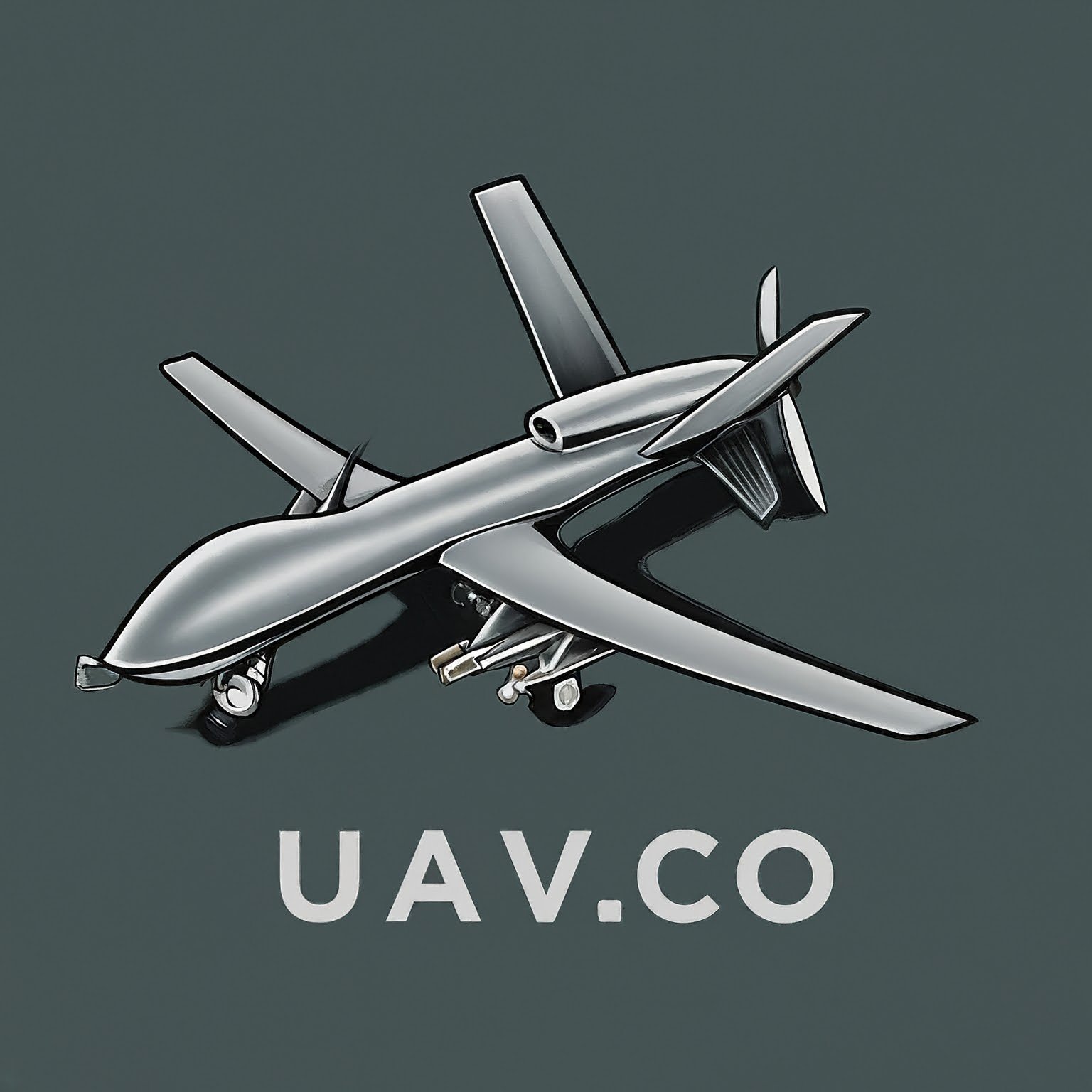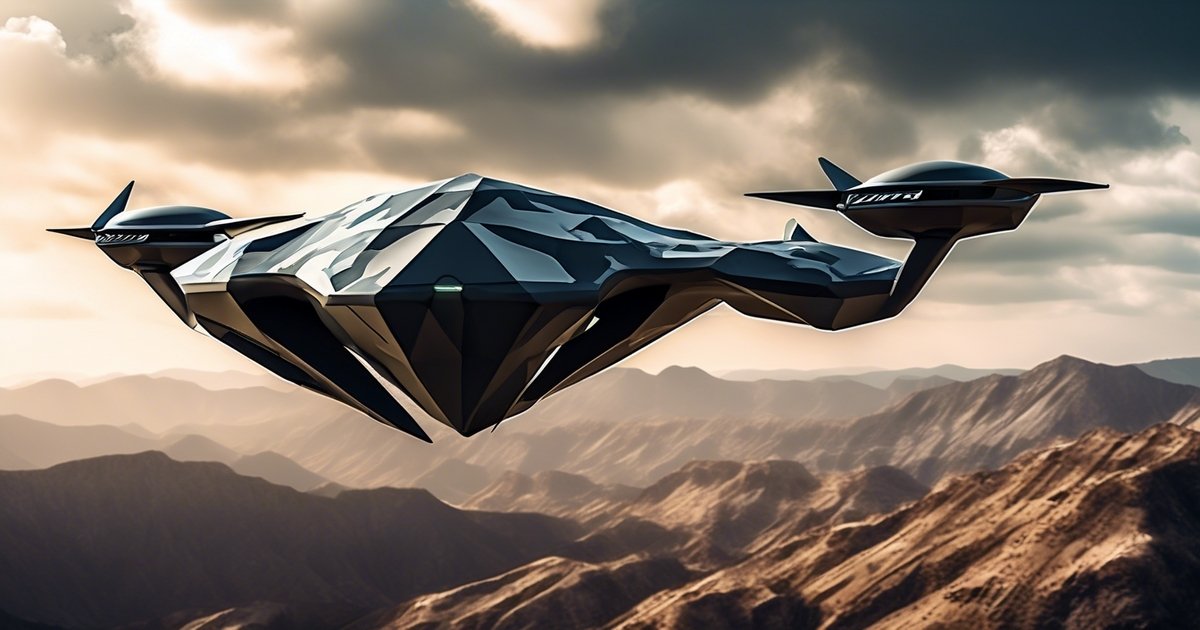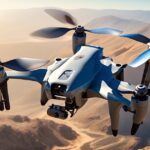Stealth military drone designs, including aerial vehicle and flying wing concepts, represent a pinnacle of modern warfare technology, combining advanced materials, aerodynamics, and cutting-edge electronics to evade detection alongside collaborative combat aircraft and manned aircraft. These drones, unlike manned aircraft and stealth bombers, play a critical role in intelligence gathering, surveillance, and targeted operations without risking human lives or alerting adversaries as a collaborative combat aerial vehicle. As nations invest heavily in research and development to enhance their capabilities further, understanding the principles behind these sophisticated machines, including advanced drones, stealth bombers, and other air force assets, offers insights into future combat strategies and defense mechanisms during aviation week. This exploration delves into the design and technological marvels that make stealth drones, like the Sentinel, an indispensable asset in contemporary air force military arsenals, capturing critical footage.
Key Takeaways
-
The evolution of stealth technology in drones highlights the significant advancements in making these aerial vehicles less detectable, enhancing their effectiveness in surveillance and combat missions.
-
Recent unveilings of secret stealth drone designs showcase the cutting-edge innovations in aerodynamics, materials, and electronic systems, contributing to their low visibility on radar and other detection systems.
-
The operational history of stealth drones demonstrates their increasing role in modern warfare, providing real-world examples of their strategic advantages in various military operations around the globe.
-
Advanced specifications of stealth drones, including enhanced endurance, payload capacity, and integrated technologies, make them a formidable tool in the arsenal of any modern military force.
-
With a growing number of global operators, stealth military drones are becoming a key component of national defense strategies, reflecting their value in achieving tactical superiority without risking human lives.
-
Looking ahead, future trends in stealth drone capabilities, such as AI-driven autonomous operations and further improvements in stealth technology, are set to revolutionize military tactics and redefine the landscape of autonomous warfare.
Evolution of Stealth Technology in Drones
Early Beginnings
Stealth technology in air force drones, like the Sentinel, first appeared late in the 20th century with advanced design. Researchers focused on making drones invisible to radar. They used special materials and shapes.
These early models were basic. Yet, they laid the groundwork for future advancements. The focus was on surveillance without detection.
Material Advances
The development of stealth technology for advanced drone and air sentinel applications saw rapid progress with new materials, including the Thanatos drone. Engineers experimented with composites that absorbed radar waves. This reduced a drone’s visibility significantly.
Aerodynamics played a crucial role too. Sleek designs minimized air resistance and radar signature. These innovations made drones harder to detect and track.
AI Integration
Artificial Intelligence (AI) revolutionized stealth drones further. AI allowed for autonomous evasion maneuvers, enhancing survivability against anti-aircraft systems with stealth capabilities, acting as a sentinel.
Drones could now react to air threats faster than human pilots could manage; this boosted their effectiveness in sentinel reconnaissance missions.
Secret Stealth Drone Designs Unveiled
Minimal Radar
A recent leak has unveiled new stealth military drone designs, including the Sentinel. These designs focus on reducing the radar cross-section significantly. This feature is crucial for evading enemy detection.
The techniques employed include shaping the drones to deflect radar waves away. Materials that absorb radar signals are also used. Together, these strategies make the drones nearly invisible to radar systems.
Blended Bodies
One standout feature in these designs is the use of blended wing bodies. This approach merges the drone’s body and wings into a single smooth shape.
This design minimizes disruptions in airflow and reduces radar signatures. It represents a leap forward in stealth technology, making drones harder to detect and track.
Autonomous Shift
The evolution of these designs highlights a shift towards fully autonomous operations. Drones are now capable of executing complex missions without direct human control.
This progression includes advanced navigation systems and AI-driven decision-making processes. Such capabilities enable uncrewed aircraft to operate more effectively in hostile environments.
Operational History of Stealth Drones
First Deployment
Stealth drones first saw action in the early 21st century. Their use marked a significant shift in military strategy. Initially, these drones focused on surveillance missions. They gathered intelligence without being detected.
The introduction of stealth technology allowed for deeper penetration into enemy territory. This was without risking human lives or expensive aircraft.
Notable Missions
Several missions have highlighted the capabilities of stealth drones. They have flown over hostile territories undetected. For example, some were used to monitor militant activities in regions where traditional aircraft could not venture without being spotted.
These operations provided critical data for military planning and decision-making. The success of these missions showcased the strategic advantage offered by stealth drone designs.
Evolution in Roles
Over time, the role of stealth drones expanded beyond reconnaissance. They began engaging targets directly. This evolution from eyes in the sky to active participants on the battlefield demonstrated their versatility.
Drones equipped with precision strike capabilities could eliminate high-value targets with minimal collateral damage.
-
Surveillance: Initial focus on gathering intelligence.
-
Engagement: Shift towards direct action against enemy assets.
Advanced Specifications of Stealth Drones
Next-Gen Sensors
Stealth drones are equipped with cutting-edge sensors. These sensors collect and transmit data in real time. They enable the drone to navigate complex environments.
The use of advanced sensors enhances the stealth features of these drones. It allows them to remain undetected by enemy radar systems. This capability is crucial for intelligence, surveillance, and reconnaissance missions.
Electronic Warfare
These unmanned aircraft integrate capabilities for electronic warfare and cyber operations. They can disrupt enemy communications and radar systems.
This integration extends their utility beyond traditional reconnaissance roles. Stealth drones can now actively participate in electronic attacks against hostile targets.
Efficient Propulsion
Stealth drones boast efficient propulsion systems that extend their flight duration and range significantly.
For example, some advanced designs incorporate hybrid engines or solar power technologies. These innovations allow for longer missions without the need for frequent refueling or recharging.
-
Benefits include:
-
Extended operational range
-
Increased time on target
-
Reduced logistical footprint
-
Global Operators of Stealth Military Drones
Leading Powers
The United States, China, and Russia dominate the scene in operating stealth military drones. Their air forces possess advanced fleets, showcasing a range of designs from reconnaissance to strike capabilities. The USA’s Sentinel drone represents a pinnacle in stealth technology, capable of evading radar detection over hostile territories.
These countries not only operate but also lead in the development of such drones. Collaboration on research and operational strategies is common among them. This ensures their dominance in aerial warfare continues to grow.
International Expansion
Smaller nations are increasingly adding stealth drones to their arsenals through international deals. Countries like Israel and Turkey have emerged as suppliers, bridging the gap between leading powers and smaller states. This trend highlights a shift towards more countries recognizing the strategic value of stealth technology in modern warfare.
Moreover, collaborations beyond borders for developing these drones have become prevalent. Joint ventures bring together diverse expertise, fostering innovation across continents. For instance, European nations are working collectively on projects that could rival those of the leading powers.
Stealth military drone designs have revolutionized modern warfare by offering unparalleled advantages in surveillance and combat operations. As more countries join this elite club through acquisitions or partnerships, global military dynamics continue to evolve rapidly.
Revolutionary Autonomous Warfare Tactics
Swarm Tactics
Swarm tactics revolutionize combat strategies. They involve multiple drones working together to overwhelm enemy defenses. This approach increases the effectiveness of missions by distributing the risk among many vehicles rather than a single unit.
The concept behind swarm tactics is not just about numbers. It’s about coordination and adaptability. These drones can autonomously adjust their actions based on real-time data, making them unpredictable for adversaries.
AI Integration
Artificial Intelligence (AI) plays a crucial role in dynamic mission planning. It allows drones to prioritize threats and objectives without human intervention. This capability ensures that operations are both swift and strategic.
AI integration also enhances decision-making processes. Drones can evaluate situations and decide on the best course of action in seconds. This speed is vital for success in modern warfare where conditions change rapidly.
Decentralized Decisions
Decentralized decision-making marks a shift from traditional command structures. Each drone in a swarm can make independent decisions based on shared information. This autonomy reduces the vulnerability of missions to communication failures or jamming attacks.
Benefits include improved survivability and efficiency in complex environments. Drones can reroute or change tactics instantly, making them formidable opponents.
Future Trends in Stealth Drone Capabilities
Hypersonic Speeds
The quest for hypersonic speeds is reshaping stealth military drone designs. These drones aim to outpace anti-aircraft systems, making interception nearly impossible. They fly at speeds exceeding Mach 5.
Hypersonic drones complicate enemy detection and response times. Their rapid movements allow for swift, targeted strikes without prior notice.
Advanced Autonomy
Stealth drones are evolving towards greater autonomy. This shift leverages machine learning algorithms to execute complex maneuvers unpredictably. Such capabilities enhance their evasion from enemy radars and anti-air systems.
Autonomous drones can assess situations and make decisions faster than human pilots. They adapt in real-time, ensuring mission success even in dynamic combat environments.
Directed Energy Weapons
Integration of directed energy weapons (DEWs) marks a significant advancement. DEWs offer silent yet potent offensive options for stealth drones, enabling precise strikes with minimal collateral damage.
These weapons disrupt or destroy targets through focused energy beams like lasers. Their use on stealth platforms underscores the move towards quieter, more lethal aerial warfare tactics.
Impact and Role of Stealth Drones in Military Operations
Risk Reduction
Stealth drones have revolutionized military strategies. They protect human pilots by operating in dangerous zones. These unmanned systems navigate contested airspaces safely.
The shift to drones has been significant. It reflects a strategic choice to minimize human casualties. Technologies enable these crafts to perform complex maneuvers without direct human control.
Deep Penetration
These drones execute deep penetration strikes efficiently. Their design minimizes detection, reducing political and military backlash. This capability is vital for sensitive operations.
Operations can be carried out with precision. The impact on surrounding areas is lessened, making stealth drones preferable for targeted actions.
ISR Missions
Intelligence, surveillance, and reconnaissance (ISR) are critical roles for stealth drones. They gather essential data from hostile territories without being noticed.
This information supports decision-making processes at high levels of command. Stealth technology ensures the safety of these missions, enhancing their effectiveness.
Targeted Elimination
For targeted elimination missions, stealth drones offer unparalleled advantages.
-
Precision
-
Reduced collateral damage
-
Anonymity
Such operations often require quick action with minimal noticeability. Stealth military drone designs make this possible.
Closing Thoughts
The exploration of stealth military drone designs reveals a trajectory of technological advancement and strategic deployment that has significantly shaped modern warfare. From the evolution of stealth technology in drones to their operational history, and from the unveiling of secret designs to the discussion of future trends, this article has traversed the complex landscape of autonomous warfare tactics and their global implications. The synthesis of these sections underscores the pivotal role stealth drones play in enhancing military operations, offering both tactical superiority and a layer of security through anonymity. Their impact extends beyond immediate military engagements, influencing defense strategies and international relations.
As the world stands on the cusp of further innovations in stealth drone capabilities, it becomes imperative for stakeholders in defense, policy-making, and technology sectors to engage with these developments proactively. The insights provided here invite further research and discussion on optimizing these technologies for peacekeeping and defense, ensuring that their potential is harnessed responsibly. Readers are encouraged to delve deeper into the subject, fostering a well-informed community prepared to address the challenges and opportunities that lie ahead.



